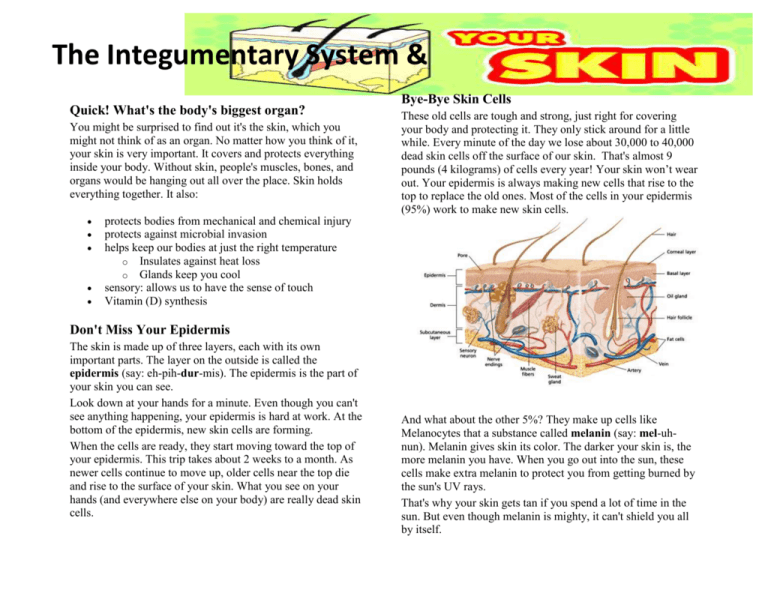
The Integumentary System &
Quick! What's the body's biggest organ?
You might be surprised to find out it's the skin, which you
might not think of as an organ. No matter how you think of it,
your skin is very important. It covers and protects everything
inside your body. Without skin, people's muscles, bones, and
organs would be hanging out all over the place. Skin holds
everything together. It also:
Bye-Bye Skin Cells
These old cells are tough and strong, just right for covering
your body and protecting it. They only stick around for a little
while. Every minute of the day we lose about 30,000 to 40,000
dead skin cells off the surface of our skin. That's almost 9
pounds (4 kilograms) of cells every year! Your skin won’t wear
out. Your epidermis is always making new cells that rise to the
top to replace the old ones. Most of the cells in your epidermis
(95%) work to make new skin cells.
protects bodies from mechanical and chemical injury
protects against microbial invasion
helps keep our bodies at just the right temperature
o Insulates against heat loss
o Glands keep you cool
sensory: allows us to have the sense of touch
Vitamin (D) synthesis
Don't Miss Your Epidermis
The skin is made up of three layers, each with its own
important parts. The layer on the outside is called the
epidermis (say: eh-pih-dur-mis). The epidermis is the part of
your skin you can see.
Look down at your hands for a minute. Even though you can't
see anything happening, your epidermis is hard at work. At the
bottom of the epidermis, new skin cells are forming.
When the cells are ready, they start moving toward the top of
your epidermis. This trip takes about 2 weeks to a month. As
newer cells continue to move up, older cells near the top die
and rise to the surface of your skin. What you see on your
hands (and everywhere else on your body) are really dead skin
cells.
And what about the other 5%? They make up cells like
Melanocytes that a substance called melanin (say: mel-uhnun). Melanin gives skin its color. The darker your skin is, the
more melanin you have. When you go out into the sun, these
cells make extra melanin to protect you from getting burned by
the sun's UV rays.
That's why your skin gets tan if you spend a lot of time in the
sun. But even though melanin is mighty, it can't shield you all
by itself.
The Dermis Is Under the Epidermis
The next layer down is the dermis (say: dur-mis). You can't
see your dermis because it's hidden under your epidermis. The
dermis contains nerve endings, blood vessels, oil glands, and
sweat glands and hair follicles. It also contains collagen and
elastin, which are tough and stretchy.
The nerve endings, part of the Peripheral Nervous System, in
your dermis tell you how things feel when you touch them.
They work with your brain part of the Central Nervous System,
so that your brain gets the message about what you're touching.
Exocrine Glands:
The dermis is home to the oil glands, too. These are also called
sebaceous (say: sih-bay-shus) glands, and they are always
producing sebum (say: see-bum). Sebum is your skin's own
natural oil. It rises to the surface of your epidermis to keep
your skin lubricated and protected. It also makes your skin
waterproof and prevents the loss of water. The sebum is
mildly toxic to some bacteria. Secretion of sebum is
controlled by the endocrine system. Too much hormone can
causes an overproduction of sebum and can lead to acne.
You also have sweat glands on your epidermis. Even though
you can't feel it, you actually sweat a tiny bit all the time. The
sweat comes up through pores. The water from the sweat
evaporates and allows for the cooling of the body’s
temperature.
The Third Layer Is Subcutaneous Fat
The third and bottom layer of the skin is called the
subcutaneous (say: sub-kyoo-tay-nee-us) layer. It is made
mostly of fat and helps your body stay warm and absorb
shocks. This subcutaneous layer also helps hold your skin to all
the tissues underneath it.
This layer is where you'll find the start of hair, too. Each hair
on your body grows out of a tiny tube in the skin called a
follicle (say: fah-lih-kul). Every follicle has its roots way down
in the subcutaneous layer and continues up through the dermis.
You have hair follicles everywhere, except your lips, and the
palms and soles of your hands and feet. There are more than
100,000 follicles on your head alone!
Your hair follicles rely on your sebaceous glands to bring on
the shine. Connected to each follicle in the dermis layer is a
tiny sebaceous gland that releases sebum onto the hair. This
lightly coats the hair with oil, giving it some shine and a little
waterproofing.
Hair & Nails
Your hair and nails are both made of a structural protein called
keratin. Your hair helps protect your body and keep it warm.
Your nails are harder and are designed to protect your fingers
and toes. Because your nails are hard they allow the front of
your fingers and toes to squish more which enhances nerve
sensitivity.
Adapted from KidsHealth © 1995-2013 The Nemours Foundation. All rights reserved.
Information reviewed by: Patrice Hyde, MD May 2012










